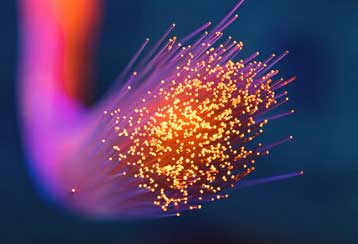Optical Fibre Care
Optical fibre and receptacle care for optimum performance
A small amount of dirt or damage on the surface of an optical fibre can cause a surprisingly large drop in signal throughput; signal loss of up to 80% is not uncommon. In a Raman spectroscopy system, such as Tornado Spectral System’s HyperFlux™ PRO Plus, this loss of fibre throughput will result in a significant drop in system performance due to less laser light exiting the sample and/or less light from the sample returning to the spectrometer. Dirt on the excitation fibre could even be burned onto the surface by the laser making it impossible to clean. If this happens the fibre would need to be replaced, adding costs and downtime. However, a little bit of preventive maintenance can extend the life of the optical fibres and keep the PRO Plus running at peak performance.
Prevention
In order to maintain fibre cleanliness, the most important step is always prevention. Any time the fibre is removed from its receptacle, immediately cover it with the cap that it was shipped with. This will keep the fibre safe both from dirt settling on the tip and accidental damage. Similarly, install the receptacle cap, which is permanently attached to the PRO Plus case, on the receptacle. Note that fibres may ship with caps that are not attached; when you remove these caps, keep them somewhere safe and easily accessible.
Why inspect, clean, inspect?
Before installing a fibre tip into any receptacle, it is highly recommended that it be inspected for dirt or damage with the use of a fibre inspection scope. If a dirty fibre is installed in the receptacle on an optical system, it can transmit that dirt to the receptacle, re-contaminating that fibre, or any other fibre which is used with that device. Simple hand-held devices like the one in Figure 1 are effective for multimode fibres with core diameters of 100μm or more. Robert Ashby, Manager of Manufacturing Operations at Tornado, a Bruker Company states, “We recommend cleaning and inspection as a preventive measure during installation.” Figure 2 illustrates a typical, clean fibre tip as observed with a fibre inspection scope. Figure 3 illustrates a few examples of dirty or damaged fibre tips. Note that dirt can take the form of particles or a residue.
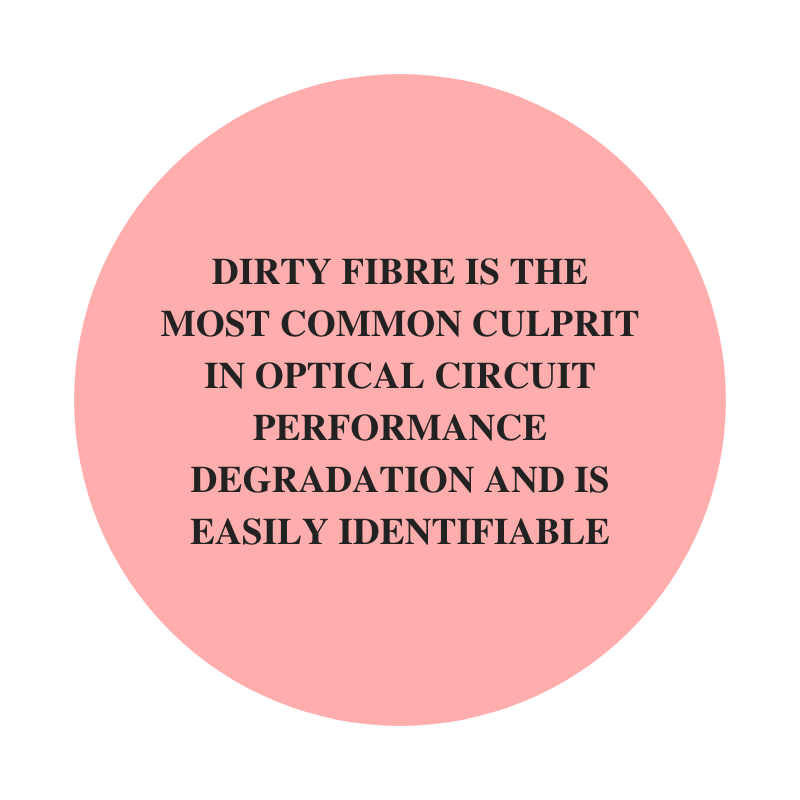

Figure 1: Fibre inspection scope (courtesy of Thorlabs)
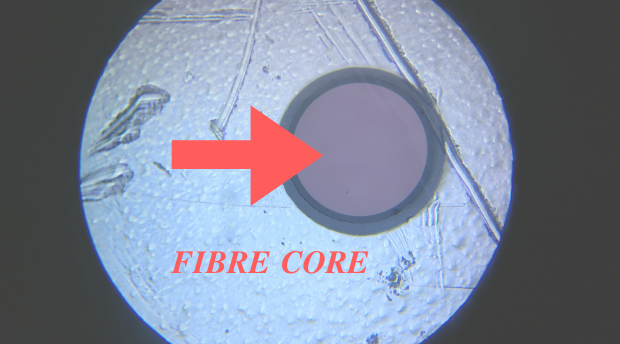
Figure 2: Clean fibre tip

Figure 3: Examples of dirty fibre tips
If material is observed on the fibre, first try to remove it with an air blower bulb. It is highly recommended that this be done with an air blower that has an air inlet valve separate from its output nozzle. This prevents the air blower from taking in dust off of a dirty surface and blowing it back onto that same surface. Most camera stores will carry air blower bulbs designed for optics and lens cleaning at a reasonable cost. An air blower bulb is also effective at cleaning dust out of fibre receptacles. Do NOT use a commercial compressed air canister or aerosol can on any optics – neither the fibre tip nor a fibre receptacle. These products contain chemicals which can be deposited on optical surfaces.
Air blowers will only remove loose particles. If the dirt particles are not removed by the air blower, there are multiple commercial fibre tip cleaning devices which can be used. A few common examples are shown in Figure 4. In all cases, be sure to read and carefully follow the manufacturer’s instructions.
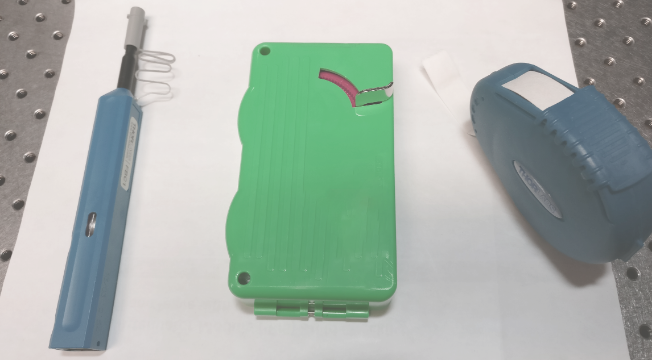
Figure 4: Commercial fibre cleaning tools
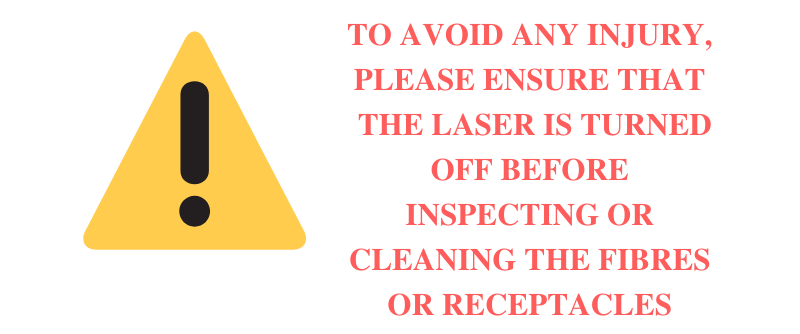
If a commercial fibre cleaning system is not available, the fibre tip can be cleaned using a lint free lens tissue and a drop of ethanol or methanol. Rest the lint free tissue on the fibre tip as illustrated in Figure 5. Be sure not to allow your fingers or any other surface to come in contact with the portion of the tissue which will be in contact with the optical fibre. Oils, dust, or dead skin cells from your hand will transfer to the tissue and contaminate the optical surface. The use of latex or nitrile gloves is recommended. Use an eye dropper to place a single droplet of methanol on the fibre tip, on top of the tissue. Slowly drag the tissue across the surface of the fibre tip. You should see the methanol spread out along the tissue and eventually dry up. The methanol should trap and remove particles of dirt but can evaporate, depositing a residue on an optical surface. Dragging the tissue across the fibre tip until it has fully absorbed the methanol droplet ensures that no residue is left behind. For this same reason it is recommended that only one single small droplet of methanol is used. Once the fibre tip has reached a dry spot on the tissue, remove it, and check the cleanliness with a fibre scope. If the dirt is still present, repeat the process using a clean, lint free tissue.
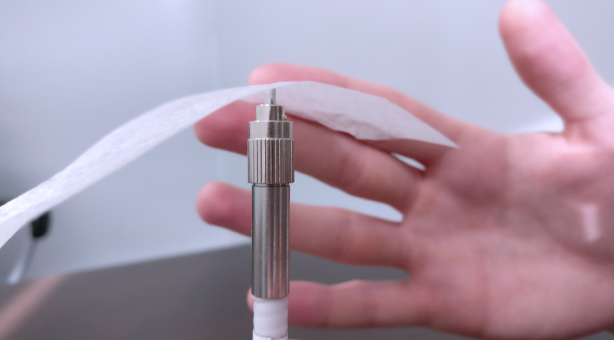
Figure 5: Cleaning a fibre with a lint-free tissue and methanol
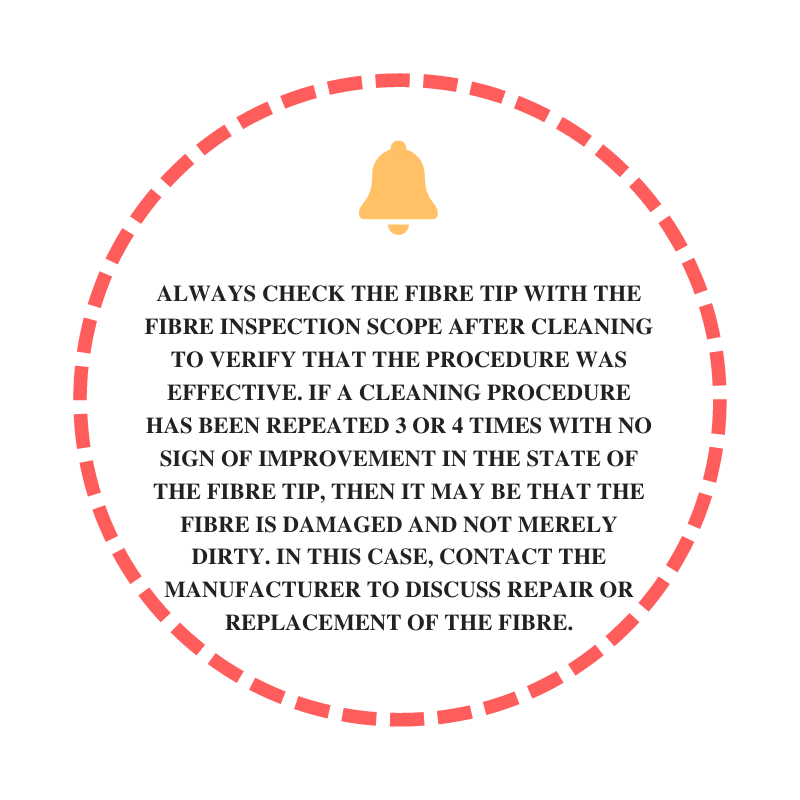
Conclusion
When care is taken to keep optical fibres and receptacles clean, they can operate for many years without problems. Of course, the odds of a fibre becoming dirty or damaged increase the more often the fibre is removed from its receptacle and handled. Keeping a fixed system in which fibres do not need to be moved or swapped will reduce the chances of failure. Remember that it is still possible, over time, for any system using fibre optics to encounter damage to the fibre cable tips. If you experience a sudden drop in signal or power throughput in your system, a dirty or damaged optical fibre is a likely cause.
Ensuring that the PRO Plus system’s optical fibres are clean and properly maintained is an easy and simple investment with a large return. It is crucial that fibres receive proper attention to maximize their lifetimes and to enable the PRO Plus to reliably address even the most demanding Raman spectroscopy applications.
For more best practices on optical fibre cleanliness and maintenance, or to source these tools, please contact us at sales.tornado@bruker.com.


